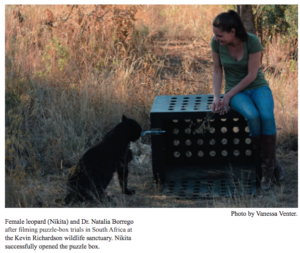Borrego Studies African Wildlife and its Future
 “Biology blends the best of both worlds for me. My father was a veterinarian, so I grew up with animals and rehabilitating wildlife. My mother was a flight attendant, so she traveled a lot. Biology gave me this wonderful opportunity to study science and ask questions about how nature works, but also to travel to these wonderful foreign locations like Africa, where I’ve done my work on the behavior of lions.”
“Biology blends the best of both worlds for me. My father was a veterinarian, so I grew up with animals and rehabilitating wildlife. My mother was a flight attendant, so she traveled a lot. Biology gave me this wonderful opportunity to study science and ask questions about how nature works, but also to travel to these wonderful foreign locations like Africa, where I’ve done my work on the behavior of lions.”
That is how Dr. Natalia Borrego explains how she got into biology. A native of Lubbock, Texas, she went on to obtain a bachelor’s in wildlife ecology and conservation from the University of Florida, a master’s in environmental science from Florida Gulf Coast University, and a doctorate in biology from the University of Miami (Florida). Today she teaches in the Department of Natural Sciences of the Weissman School of Arts and Sciences at Baruch College of the City University of New York.
Borrego began her career by studying a well-known environmental toxin: mercury. “We found that blackbirds accumulate mercury, but they deal with it by molting their feathers and shedding mercury that way. They can also shed mercury in their eggs,” she says.
But soon, she turned her attention to the big mammals of Africa. “I was interested in working with lions and their relatives—tigers, jaguars, and leopards. I started off with a question rather than with a single species. I was interested in the evolution of intelligence and problem-solving, and in how those may differ between social and nonsocial species,” says she.
Yet to measure intelligence among big cats is not an easy task. “Lions are a bit difficult. They are very large and destructive. Think of a house cat but in a giant size—they love to play. The trick was to try to figure out how to adapt tests that have been used in other species to this giant carnivorous species.”
wild and in captivity, but one wonders to what extent captivity modifies their natural behavior. “I did do tests with a puzzle box with lions out in the Serengeti in Africa. I compared those results with the lions that were in captivity, and we didn’t see a significant difference in their performance. It doesn’t seem, at least from this test, that captivity is affecting their ability to solve a problem.”
One of Borrego’s major findings is that social carnivores outperform asocial carnivores when it comes to solving problems. “Social carnivores are also more exploratory than nonsocial carnivores. There are still a lot of questions, and we need to keep doing these comparisons and to do them among a broad range of species to really get the picture of how intelligence evolves,” says she. Another important finding of Borrego’s research is that hyenas are smarter than leopards, which is surprising, given that hyenas are basically scavengers. “The hyenas are amazing, the spotted hyenas in particular. They have these extremely complex societies. It’s a matriarchy, so they have strict dominance hierarchies, but the females are the rulers. You’ll inherit your rank from your mother, so it’s a very primate-like society,” says Borrego.
With these feline examples in mind, one wonders to what extent human sociality was a major factor in the evolution of our species. “There has been discussion about how human sociality has shaped the evolution of our cognition. The original proposal of this hypothesis was to get at that question in a way that would also apply to humans. Why are we so superior to other species? How is it that we’ve evolved such massively superior intelligence? The idea is that something about sociality forced us to evolve these very large brains with good problem-solving skills,” she mentions. Besides her studies of animal behavior, Borrego has been involved in conservation issues, one of them being the human-elephant conflict in South Africa. “Elephants are very intelligent, and they can also be aggressive. If you get in their personal space, they are going to tell you to move, and the way they do that is by chasing you. You get males that are going through what is called must, which makes them an extra bit aggressive and territorial. The problem is that you’ll have these safari vehicles, or you’ll have tourists out wanting to see the elephants, but the elephants might be having a bad day that day. What’s important is to figure out how to predict elephant behavior so as to avoid human-elephant conflict in tourism-type settings, rather than just to prevent poaching.”
Is there a bright future for elephants in Africa, given the pervasiveness of illegal hunting, environmental degradation, and local corruption? “South Africa’s animals are actually doing quite well, but it’s because their reserves are all fenced. They have large areas of land set aside for them, but by fencing them in, you create these heavily managed populations. For instance, throughout the rest of Africa, we know that lion populations are declining, and there are problems with trophy hunters and corruption that will end up harming the populations. Whereas in South Africa there is the opposite problem—too many lions. They have more lions than they know what to do with. Lions, if you give them food and land, are kind of like rabbits in how often they can have babies. You have all these cubs, but the issue is that they have nowhere to disperse to,” explains Borrego.
PDF Version:
Borrego Studies African Wildlife and its Future